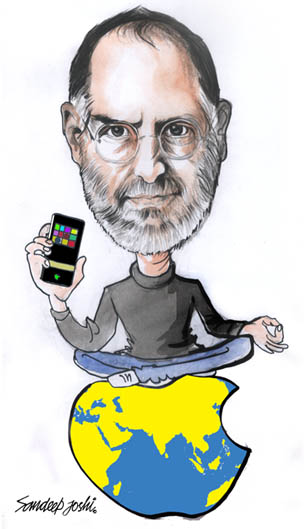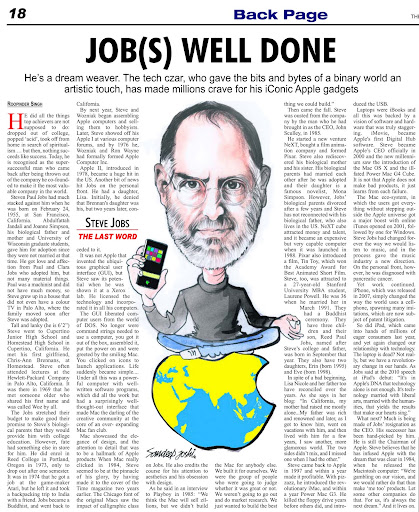He’s a dream weaver. The tech czar, who gave the bits and bytes of a binary world an artistic touch, has made millions crave for his iConic Apple gadgets
ROOPINDER SINGH

HE did all the things top achievers are not supposed to do: dropped out of college, popped ‘acid’, took off from home in search of spiritualism … but then, nothing succeeds like success. Today, he is recognised as the super-successful man who came back after being thrown out of the company he co-founded to make it the most valuable company in the world.
Steven Paul Jobs had much stacked against him when he was born on February 24, 1955, at San Francisco, California. Abdulfattah Jandali and Joanne Simpson, his biological father and mother and University of Wisconsin graduate students, gave him for adoption since they were not married at that time. He got love and affection from Paul and Clara Jobs who adopted him, but not many material things. Paul was a machinist and did not have much money, so Steve grew up in a house that did not even have a colour TV in Palo Alto, where the family moved soon after Steve was adopted.
Tall and lanky (he is 6’2″) Steve went to Cupertino Junior High School and Homestead High School in Cupertino, California. He met his first girlfriend, Chris-Ann Brennans, at Homestead. Steve often attended lectures at the Hewlett-Packard Company in Palo Alto, California. It was there in 1969 that he met someone older who shared his first name and was called Woz by all.
The Jobs stretched their budget to make good their promise to Steve’s biological parents that they would provide him with college education. However, fate had something else in store for him. He did enrol in Reed College in Portland, Oregon in 1973, only to drop out after one semester. It was in 1974 that he got a job at the game-maker Atari, but he left it and took a backpacking trip to India with a friend. Jobs became a Buddhist, and went back to California.
By next year, Steve and Wozniak began assembling Apple computers and selling them to hobbyists. Later, Steve showed off his Apple I at various computer forums, and by 1976 he, Wozniak and Ron Wayne had formally formed Apple Computer Inc.
Apple II, introduced in 1978, became a huge hit in the US. Another bit of news hit Jobs on the personal front. He had a daughter, Lisa. Initially, he denied that Brennan’s daughter was his, but two years later, conceded to it.
It was not Apple that invented the ubiquitous graphical user interface (GUI), but Steve saw its potential when he was shown it at a Xerox lab. He licensed the technology and incorporated it in all his computers.
The GUI liberated computer users from the world of DOS. No longer were command strings needed to use a computer, you got it out of the box, assembled it, put the power on and were greeted by the smiling Mac. You clicked on icons to launch applications. Life suddenly became simple…. Under all this was a powerful computer with well-written software programs, which did all the work but had a surprisingly well-thought-out interface that made Mac the darling of the creative community at the core of an ever- expanding Mac fan club.
Mac showcased the elegance of design, and the attention to detail that was to be a hallmark of Apple products When Mac really clicked in 1984, Steve seemed to be at the pinnacle of his glory, by having made it to the cover of the Time magazine two years earlier. The Chicago font of the original Macs saw the impact of calligraphic class on Jobs. He also credits the course for his attention to aesthetics and his obsession with design.
As he said in an interview to Playboy in 1985: “We think the Mac will sell zillions, but we didn’t build the Mac for anybody else. We built it for ourselves. We were the group of people who were going to judge whether it was great or not. We weren’t going to go out and do market research. We just wanted to build the best thing we could build.”
Then came the fall. Steve was ousted from the company by the man who he had brought in as the CEO, John Sculley, in 1985.
He started a new venture NeXT, bought a film animation company and formed Pixar. Steve also rediscovered his biological mother and his sister. His biological parents had married each other after he was adopted and their daughter is a famous novelist, Mona Simpson. However, Jobs’ biological parents divorced after a few years and Steve has not reconnected with his biological father, who lives in the US NeXT cube attracted money and talent, and it became an expensive but very capable computer when it was launched in 1988. Pixar also introduced a film, Tin Toy, which won the Academy Award for Best Animated Short Film. Steve, too, was attracted to a 27-year-old Stanford University MBA student, Laurene Powell. He was 36 when he married her in March 1991. They had a Buddhist ceremony. They have three children and their son, Reed Paul Jobs, named after Steve’s college and father, was born in September that year. They also have two daughters, Erin (born 1995) and Eve (born 1998).
In spite of a bad beginning, Lisa Nicole and her father too have reconciled over the years. As she says in her blog: “In California, my mother had raised me mostly alone…My father was rich and renowned and later, as I got to know him, went on vacations with him, and then lived with him for a few years, I saw another, more glamorous world. The two sides didn’t mix, and I missed one when I had the other.”
Steve came back to Apple in 1997 and within a year made it profitable. With pizzazz, he introduced the revolutionary iMac, and within a year Power Mac G3. He killed the floppy drive years before others did, and introduced the USB.
Laptops were iBooks and all this was backed by a vision of software and hardware that was truly staggering. iMovie, became Apple’s first Digital Hub software. Steve became Apple’s CEO officially in 2000 and the new millennium saw the introduction of the Mac OS X and the ill-fated Power Mac G4 Cube. It is not that Apple does not make bad products, it just learns from each failure.
The Mac eco-system, in which the users got everything without stepping outside the Apple universe got a major boost with online iTunes opened on 2001, followed by one for Windows. Steve Jobs had changed forever the way we would listen to music, and in the process gave the music industry a new direction. On the personal front, however, he was diagnosed with pancreatic cancer.
Yet work continued. iPhone, which was released in 2007, simply changed the way the world uses a cellphone, spawning many imitations, which are now subject of patent litigation.
So did iPad, which came into hands of millions of eager consumers last year, and yet again changed our relationship with technology. The laptop is dead? Not really, but we have a revolutionary change in our hands. As Jobs said at the 2010 speech at iPad’s debut: “It’s in Apple’s DNA that technology alone is not enough. It’s technology married with liberal arts, married with the humanities, that yields the results that make our hearts sing.”
What next? Much is being made of Jobs’ resignation as the CEO. His successor has been hand-picked by him. He is still the Chairman of Apple. Steve believes that he has infused Apple with the dream that was clear in 1984, when he released the Macintosh computer: “We’re gambling on our vision, and we would rather do that than make ‘me too’ products. Let some other companies do that. For us, it’s always the next dream.” And it lives on.
This article was published in The Tribune as Last Word on Monday, August 29, 2011.

